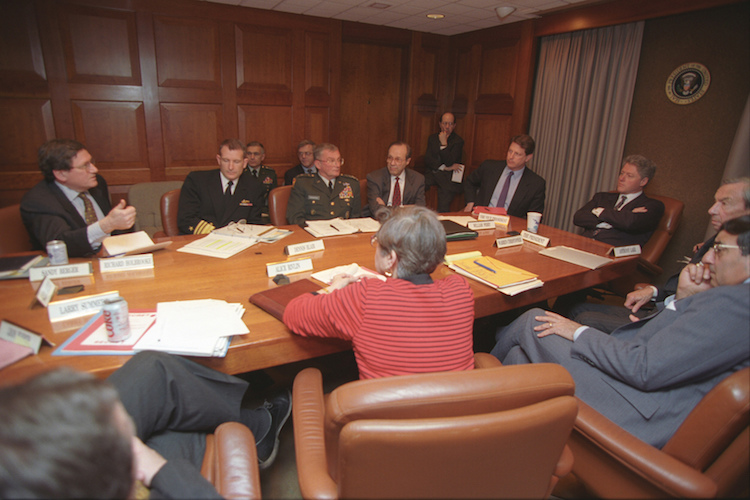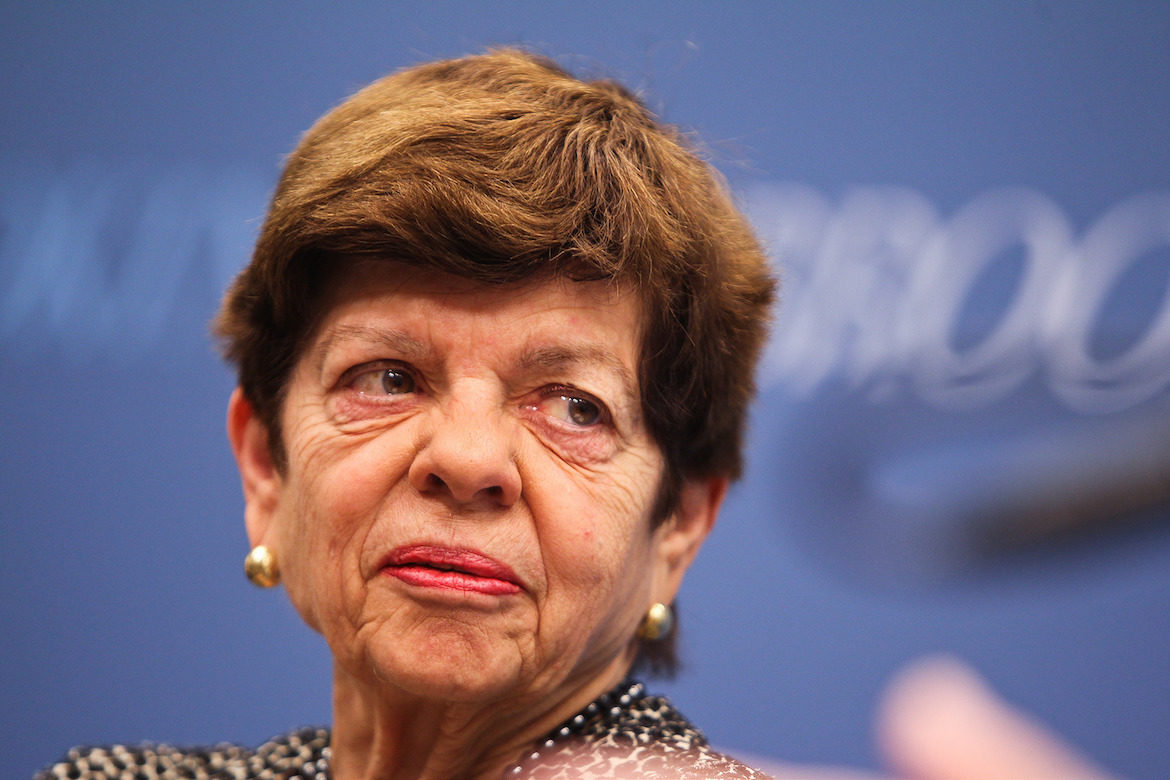When the Washington DC Fiscal Control Board was in office between 1995 and 2001, it took control of the school district, did not renew the superintendent’s contract, and instead appointed an army general.
Although she took over the board in 1998, three years after its creation, Alice Rivlin clearly recalls these episodes. It can be said that, in short, she was the brain behind the scenes of the five-member body that controlled DC’s finances for six years.
Rivlin is an economist, and reviewing some achievements of the District of Columbia Financial Responsibility and Management Assistance Authority, which was the Board’s official name, she also accepts its failures; With a soothing tone, and with the assurance of one who thinks they did the right thing.
 She chaired the DC Board while she was vice chair of the Federal Reserve’s Governing Board. During the administration of former President Bill Clinton, she headed the Office of Management and Budget, and is currently a senior fellow in the area of economics and health policy at the Brookings Institute, based in the federal capital, where she hosted the Center for Investigative Journalism.
She chaired the DC Board while she was vice chair of the Federal Reserve’s Governing Board. During the administration of former President Bill Clinton, she headed the Office of Management and Budget, and is currently a senior fellow in the area of economics and health policy at the Brookings Institute, based in the federal capital, where she hosted the Center for Investigative Journalism.
Ultimately, the Washington DC Fiscal Control Board managed to balance the budget, which had a $722 million deficit. Thousands of public employees were dismissed, changes in the school district failed, cuts to the public university were so drastic that they still can not recover, and the city continues to face affordable housing problems. By 2011, 10 years after the Board’s intervention, it was estimated that the city’s deficit could reach $600 million. The law that activated the board remains in effect, so it would be possible for the agency to retake control of the city’s finances, although no one bets on that happening.
One of the victims of the DC board was the public university. The budget and the number of courses were reduced, and the number of students dropped between 1994 and 1997. “Thinking back, I think they cut too much,” said Rivlin.
“In early 95, Washington DC was hemorrhaging money. They (the city) didn’t actually miss a payroll payment but they were about to. The only reason they didn’t was that the nonprofit organizations that ran a lot of the city’s services, like daycare centers and seniors centers and things like that, weren’t getting paid. They kept the services going without getting paid but you cannot do that forever, so we realized we had to do something,” Rivlin recalled.
“In general, if a city gets into trouble, it is the state that does something, but here (in DC) there was no state. So the federal government had to intervene. Clinton asked me if I could do that because he knew about these things and because that task was natural for the budget director. So I worked with the Congress, which at the time was Republican, to set up a federal control board. We modeled it on the Pennsylvania statute and got Congress to work with us to pass the law. That’s how we had a five-member board and gave it the power to overwrite the city’s government and to also create — this was the important part — the Office of the Chief Financial Officer as an independent office and that has survived until this day and is extremely useful. My role at that time was simply to appoint the (board) members to help them find a CFO, which we did, and to work with them a little bit, but I was not on the first board.”

How was the process of selecting the members of the Board, what kind of qualities were you looking for, what profile?
We wanted them all to be District residents, we thought that was very important for credibility in the District.
“Actually, in the end we had this resident criterion and we wanted mostly African-American people because this is a majority African-American city. Eleanor Norton, who was the DC representative in the Congress comparable to Puerto Rico’s, worked with us on this. She did a lot of the political legwork and Eleanor insisted, she wanted all African-Americans and all District residents. But we were also looking for a spectrum of skills. We wanted someone with strong accounting skills, we wanted a lot of managing skills. We got a Vice President of Howard University, we got somebody from one of the utilities, a manager from a telephone company I think, and we had somebody who had been on the federal government in charge of personnel.”
“The Chair was an economist, Andrew Brimmer. That’s where we started. Andrew and I went to college together, he had been on the Federal Reserve, he’d had a good career there and he was actually running an economic consulting company, which was convenient because he could put a lot of time into it. The only exception was the accountant, who was white and lived in the suburbs, but was the ideal person for the position.”
When they were recruited, did these people know or understand that they were coming to cut jobs?
“Well, that was one of the things, you know, “what are we doing in this situation and how do we get the city back on track?” because we couldn’t borrow money. The credit was so low that they were shut out of the debt market even for short-term borrowing. So it was a question of how quickly they could balance the budget by cutting expenditures or raising revenue or both; and they did both. But, the real problem was how to keep this from happening again and then you get back into asking yourself how do you grow the employment base and the tax base, basically, how do you grow the employment base?”
In the private sector?
“Private or public. The special problem that the District (of Columbia) had, and still does, was that it had plenty of jobs, it wasn’t a job problem. But many of the people who held jobs, especially well paying jobs, lived in the suburbs. They weren’t even residents of the District of Columbia and Congress had passed a law that said than non-resident income could not been taxed by the District. That is very unusual. All states tax income earned in their borders, no matter who generates it. The law is still there so that was the big impediment to raising revenue in the District. At the time, the city was losing population, as is Puerto Rico and Detroit.”
“When things aren’t going well, people move out and the people who move out are the people who can move out, leaving behind older, poorer, sicker people. The District had been losing population for quite a long time. It wasn’t a new phenomenon. But that has turned around and one of our efforts after the situation stabilized was to see what we could do to increase the population, get people coming back or staying. The thing that is interesting about the District is young people: young professional people come to the District early in their careers. They flock here, but they don’t stay. As soon as they get married and have kids they move to the suburbs where the schools are better and the housing is cheaper.”
Is there a housing problem here?
Affordable housing is still a problem. But the effort was to get more people to move into the city or not to leave in their 30s or when they were building families. That has been fairly successful. If you look around the city, you will see the schools are better than they were and the school population is growing again. But I met yesterday with the President of the University of the District of Columbia, they were one of the casualties of the Control Board. The University’s budget was cut back, it lost students and it was really quite drastic, and it has taken them a long time to recover.
The University of Puerto Rico is one of the first places that is facing major cuts. We have protests. In the case of DC, did the people protest? How did the Board deal with that?
“Yes, people protested and there marches and signs and stuff. By the time I became Chairman, most of that was over. But there was one exception: As the Board was about to finish its mandate because we met the criteria of five balanced budget in a row, there was a very serious problem at the public hospital, which was not a very efficient hospital. It was quite a small in-patient population and some of the patients should not really have been there, they were more nursing home patients than hospital patients. But they weren’t discharging them to nursing homes, they were just keeping them in the hospital and they weren’t billing Medicai, which they could have. The leadership of the public hospital was very sort of old-fashioned liberal, they were committed to free care and they weren’t bothered to billed Medicaid which they could have done. So it was a mess from a financial point of view. There was a lot of protest, particularly from the hospital workers. They marched and they picketed the institution and they picketed my house.
“The stormiest thing was the final meeting of the Board on this matter. We tried to make it a public meeting and it happened to coincide with World Bank and International Monetary Fund meetings, and they were engaged in some controversial stuff that had to do with trade and there were a lot of young activists in town, professional demonstrators. So they did their thing at the World Bank and then they came over and packed our meeting. I went into this big room to chair this meeting and I thought “who are these people?” I mean, they were all young, mostly white, they looked like they were right out of college, and they were. They were chanting and singing and…older protesters, like doctors and nurses in their white coats, they didn’t look like these young people. Anyway, we had to close the hospital.

So it was simply closed, it wasn’t sold to a private company?
We couldn’t and it became a homeless shelter and is still a controversial building. The current mayor, Mayor (Muriel) Bowser, has worked to have it closed. It became a large-family homeless shelter and that is not a good use for it and it is not a very good building anyway.
In hindsight, do you think the Board could have done something different with the University or the Hospital?
The Hospital was right, it was the right decision. The University I think it was too big a cut and some of the other programs may have been as well. But mostly I think they did the right thing, I mean they had the priorities right.
Were the priorities defined by the Board itself?
Yes.
Was there a process or law that established those priorities?
I don’t remember that there were priorities in the statute, I don’t think so…
In Puerto Rico, the PROMESA Act mentions “essential services,” but the issue is, how are they defined?
Right. Exactly. And it (the DC law) may have mentioned something like that but I don’t remember exactly. Mostly they (the Board) were trying to figure it out themselves and they did a couple of things that didn’t work. The schools were not functioning well and the Board decided to take over the schools. This was before my time (chairing the Board,) it was a decision by Andrew (Brimmer.) They bought out the Superintendent’s contract and put in a new Superintendent. And they assumed the powers of the School Board. They didn’t close them down, the just assumed power. That was to give better direction to the schools, they actually got a General, an Army General, to be the Superintendent. They perceived the biggest problem was management. But it was not a success. The General was a very well-motivated, nice man, but he had never run a school system and he had spend his life in the Army, where if you gave an order something happened; and if you take over a school system and you give an order, nothing happens.”
“What he did well was fix the physical plants, the schools were very deteriorated with leaky ceilings. But the more intellectual part of the schools did not improve. And then a group of lawyers took the Board to court, and the court ruled that the Board did not have in effect the power in law to take the schools. So it was not a successful experiment.”
Laura Moscoso collaborated in this story.
This interview is part of an investigative series published in part with the support of the Ravitch Fiscal Reporting Program of the Graduate School of Journalism at the City University of New York (CUNY).



